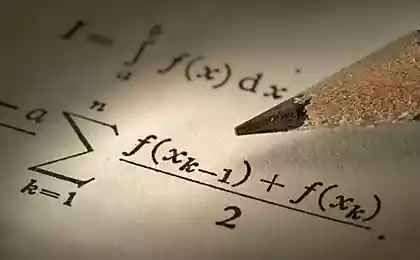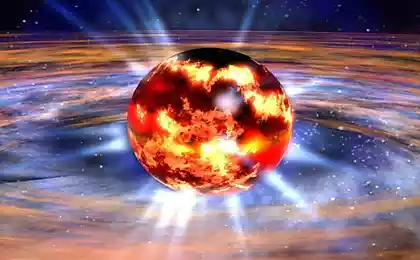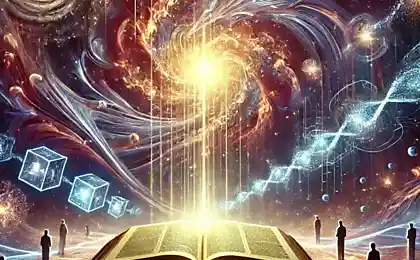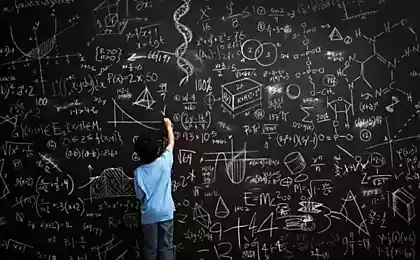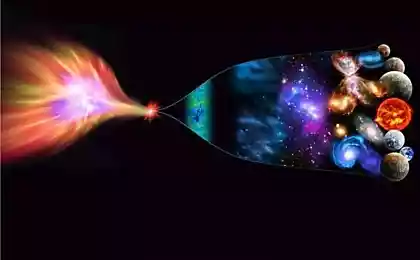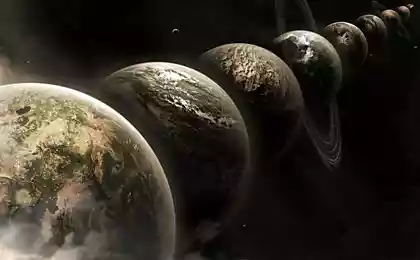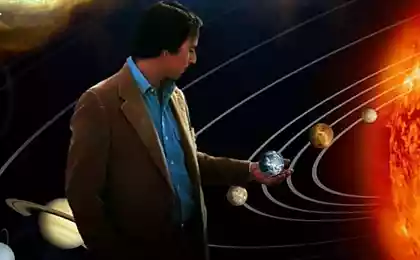816
Roger Penrose: the picture of the world on a sheet of paper
Can you draw a picture of the world with a pencil on a notebook leaf? You can, if the pencil in the hands of mathematics. But if this mathematician Professor Roger Penrose, a physicist and cosmologist, the auditor of the Big Bang theory, octogenarian gentleman from Oxford with soft manners and a boyish smile, the picture can be as unexpected as his famous "impossible triangle".
Where did the universe, how it works and what goes? This is one of the few scientific questions, has retained its universal philosophical component. The experiment in this region are still difficult or impossible, and a variety of models created out of thin air for the interpretation of empirical data, continue to tease the human imagination, as teased in the time of Thales and Epictetus.
Eighty nine million ninety three thousand six hundred twenty two
Mosaic of Penrose non-periodic: it is impossible to obtain by a simple transfer of a piece of
The cosmological model of the physicists is different from the speculative natural philosophy of antiquity fantasies that rely on vast arrays of facts, derived from high-tech observations. The cosmological model is an attempt to link the observed mathematically, if necessary, by assumptions to resolve the contradictions between the facts.
These assumptions play the role of a kind of "patches on the tissue model." Sometimes, the accumulation of information, the role of assumptions grows, and at some point it turns out that the conventional "fabric" is hardly one of the "patches". Then begins the search for alternative models in which this assumption would not be necessary.
This is what happens with the cosmological model of the Big Bang. In the equations on which this model is based, the meaning of the cosmological constant — lambda member, once called Einstein's biggest mistake, evolved from the setting of world curvature to the energy density of the vacuum, or dark energy, but remained the same dark.
Hypothetical particles of dark matter, the concept of which was introduced to interpret the observations, yet no one has managed neither to catch nor to measure. New observations, meanwhile, are forced to increase the share and significance of dark matter and dark energy, changing the proportion of admissions for a fraction of the facts in the Big Bang model in favor of the first. Therefore, in parallel there are more ideas the authors are trying to put the facts into the framework of the slender cosmological theory.
Among these alternatives, superstring theory, where elementary particles arise as vibrations of the vacuum; the theory of branching hypersaline where black holes represent branch points, and some others, to varying degrees, researched and authoritative.
Of today's models, trying to "overthrow" standard, tend to be alternative in one sense of the word: they have a particular interest in the rendering of his material. Most of the mathematics underlying big physics seems to be somewhat tired of the dictatorship of computing and now, armed with technical capabilities, more than always ready to Express their reality visually.
In Russia the development of alternative physical models is of particular interest founded in 2009, research Institute Hypercomplex systems in geometry and physics. This spring at the invitation of the Director of the Institute D. G. Pavlov two of its seminars were attended by one of the most bright living cosmologists-the alternatives and geometry-"Visualizer" — an outstanding British mathematician sir Roger Penrose.
When the information about the visit appeared and was published the schedule of public lectures in Moscow and St. Petersburg, a young professional network blog wrote: "Tell the students to dump it all and went to Penrose; explain to them what it's like if they came to the Buddha and albert Einstein in one person."
Physicist and cosmologist, in the 1950s, created under the influence of Escher your textbook famous "impossible triangle", in 1988, shared with Stephen Hawking physical prestigious wolf prize, the winner of the Dirac medal and a list of other awards, honorary member of the six universities in the world, in Russia Penrose has lectured on the cyclic model of the Universe, and took part in seminars of the research Institute gsgf, and in between the workshops, kindly agreed to give an interview to the magazine "Science and life".
A word to him.
Seven million two hundred forty seven thousand forty four
About the theory and facts
My research is mostly theoretical, often their idea is to take something from the nonphysical region and to Express in a slightly different way, to bring a slightly different understanding, such as math. Which of the methods — experimental or speculative — perceives the world more clearly than the other, is sometimes the question is quite subjective, I'm not sure of the answer.
I mean that to develop the theoretical idea and to find its confirmation in the experiment — "Aha! The way it is!"that's in basic science seldom occurs. Although cosmology is perhaps closest to that. I am now busy with a cosmological theme, and I think that there are facts that support my scheme. Although, of course, gives reason for debate.
The basic idea of my theory is pretty insane. You know, with fancy theories are many, and most of the "crazy ideas" is wrong, but this, I think there's a chance. It fits a lot of facts. Not saying that it convinces with its clearness, it would be an exaggeration, but nevertheless there are many data that are consistent with the predictions of this theory and which are difficult to explain based on traditional models.
In particular, on the basis today of the Big Bang model. I adopted this model for many years. Partly it is based on observation — people are seen corresponding to the microwave background of the Universe, it really exists; and partly on theory. From Einstein's theory, some mathematics, relevant to it, and from General physical principles, it follows that the Big Bang was supposed to happen. And evidence of the Big Bang, is also very convincing.
Aberrant
The Big Bang is something very strange. This thing bothered me for several decades. The majority of cosmologists for some mysterious reason, do not pay attention to it, but I'm always puzzled. This strangeness is associated with one of the most well-known physical principles — the second law of thermodynamics, which tells you that chance is the element of chance is increasing over time.
It is quite obvious that if entropy increases towards the future, if we look at the past, it should decrease and sometime in the past to be very low. Therefore, the Big Bang must be a very organized process, with a very small element of entropy.
However, one of the main observable in the microwave background of the characteristics of the Big Bang is that it is extremely random, arbitrary nature. Here is a graph showing the frequency spectrum and the intensity of each frequency: if we move along this curve, it appears that she has a random nature.
A coincidence — this is the maximum entropy. The contradiction is quite obvious. Some believe that this may be due to the fact that the universe then was small, but now has become big, but it can't explain and have understood it for a long time. Famous American mathematician and physicist Richard Tolman realized that the expanding universe is not an explanation and that the Big Bang was something special.
But how special, I did not know until the formula Bekenstein — Hawking associated with black holes. This formula fully demonstrates a "feature" of the Big Bang. All that can be seen on the curve — randomised, has a random nature. But there is something that you just don't see gravity. Her hard "view": gravity is a very homogeneous, uniform.
Its a very evenly distributed field is what you usually see. From this follows, that the gravity of very low entropy. This is the most incredible thing, if you will: there is gravity, so there is low entropy, everything else is more. How can this be explained? Previously, I assumed that the strangeness lies in the field of quantum gravity.
There is a perception that in order to understand the Big Bang, we need to understand quantum mechanics, and gravity, need a way to combine them, a theory that would give us a new view of gravitation in the framework of quantum mechanics and which we have not. But quantum mechanics and gravity can not explain this huge asymmetry in time, with which I began.
There is the singularity of the Big Bang, which is characterized by a very low entropy, and singularity of black holes, which, in contrast, has a very high entropy. But the Big Bang and black holes are two completely different things. It needs no explanation. I know there is a theory, like the Universe, there are some specifics of the processes in the young Universe, but I never liked it as an explanation.
Six or seven years ago, I suddenly realized that to explain the nature of the Big Bang, if the use of the model of an infinite future — the idea that won the Nobel prize for physics in one of the previous years; it explored the "dark energy" (extremely, in my opinion, unfortunate name).
Far as we know, this model well explains Einstein's cosmological constant, proposed in 1915. I know I need to take into account the cosmological constant, but generally believed that it is not there. I was wrong. The facts showed just her.
On the physical nature of infinity is very similar to the Big Bang. Only change the scale: in one case small in the other — big, the rest is very similar. The gravitational degrees of freedom at the beginning, almost absent. I knew it before, but I didn't bother to associate with one another: the Big Bang and infinity are similar.
Thirty two million eight hundred forty nine thousand one hundred seventy eight
Here is the presentation on Penrose.
So there was a diagram of where the Big Bang does not give the beginning of infinity, where it exists before — as the previous cycle of the Universe (this is called EON), and where our future is very similar to the Big Bang. Crazy idea is that perhaps our Big Bang is the future of the previous Aeon.
About the mathematics in pictures
I tend to perceive math visually. There are two completely different types of mathematicians. Some belong to the elements of computing, and not very good at visualizing; others like to visualize and... (laughs) not very good at arithmetic. The best of the mathematicians of a good and in that and in other. But in General, most mathematicians usually not visualised.
I'm still a student noticed that the separation of the mathematicians. Those of us who was struggling with visualization, there were quite a few, most were stronger than in calculations. For me, visualization is easier. But some find it difficult to take pictures that I'm in a large amount of use in his lectures, especially, oddly enough, mathematicians. Mathematics ... because mathematics and that they are strong in analysis and calculations.
But I think that it is the result of a kind of selection, one of its reasons is that the visual side of mathematics is very difficult to study. I know this by experience: a student I decided to specialize in geometry, and to do graduate work, but on the practical side, my grades in algebra were higher. For a very simple reason.
I first had to see how to solve the problem, and then to have time to translate his geometric vision in an entry or two steps, not one. I write not fast, so not all questions were able to answer. And this was not algebra, algebraic solution, it was enough to record. It happens quite often: people who are strong in visualization of mathematics, show on examination results lower than analysts and thus just drop out of the science.
Therefore, in the professional mathematical environment dominated by algebraist analysts. This, of course, my personal opinion; it should be noted, however, that I've met a lot of great mathematicians who were strong geometry and a well-visualized material.
About the value of paradoxes
My triangle goes back to the Dutch artist Escher. In the early 1950-ies I went to the international Congress of mathematicians in Amsterdam and there was a special exhibition in the Stedelijk Museum: paintings of Escher's visual paradoxes. I came back from the show and think, "Wow, I want to do something in this spirit." Not exactly what I saw at the show, but something paradoxical.
I drew several pictures of the impossible, then came the impossible triangle — the most pure and simple form. I showed this letter to his father, he drew the impossible staircase, and my father and I together wrote an article where he referred to the influence of Escher, and sent a copy to Escher. He contacted my father and used it the waterfall and the stairs in his paintings. I've always loved paradoxes. The paradox reveals the truth in his own special way.
Fifty five million eight hundred sixteen thousand four hundred fifty two
I didn't realize it, but then I realized that the triangle reveals the mathematical idea that is associated with monolocale characteristics. In this triangle any single part of a consistent and possible, any detail can, for example, made of wood. But the triangle as a whole is not.
It is opposed to local consistency and global inconsistency. This is a very important concepts of mathematics — cohomology. Take the Maxwell equations. They describe electromagnetism. Created by Maxwell in the nineteenth century, they represent one of the most perfect physical works so much and so well they describe. In the formal model that I develop and which is called twitterno theory, I describe Maxwell's equations in a different form.
In this form they are quite similar to themselves, and the solutions of these equations are encoded in a form similar to that of the impossible triangle. This is a more subtle thing, but the idea is the same: there is a description using complex analytic functions, and they as the triangle, follow each other, but in the end don't connect.
As they deploy each individual point makes sense, but the principle on which they are not linked to the result with each other, exactly the same as in the impossible triangle. Maxwell's equations are hidden in this "impossibility", in the contradiction between local and global structures. One of the reasons why I am interested in, is that one of the initial motivations for this type of mathematical descriptions, twitterno theory, grew out of my astonishment, before quantum mechanics, its nonlocal character.
The paradox of Einstein — Podolsky — Rosen — have you ever heard of it? At the distance of 143 km you take two protons separated by this distance, and they continue to behave in a coordinated manner. You are experimenting with them both, but you will not be able to explain the results of the experiment, if you don't acknowledge that there is a connection.
This property of nonlocality, a very strange aspect. Which shows this property if we return to the impossible triangle? He is consistent at each point, but there is a global relationship between the elements. Twistina theory mathematically describes this relationship. This is a way to understand the properties of nonlocality that are specific to quantum mechanics.
Elements spaced from each other, remain in some way connected connection of this kind, which can be likened to communication in the impossible triangle. I, of course, slightly easier. For example, if you have two particles, as in the experiment, all somewhat complicated (twistina theory considers this case), and I hope... I really don't know how to do it, but I hope that in the future this theory will contribute to the understanding of quantum mechanics and our understanding will be based on the property of nonlocality, similar to that shown in the impossible triangle.
On the practical meaning of physical theories
It is obvious already now. For example, coding in the transmission of information. If you send a signal from A to B, someone along the way can intercept the message and read it. But in the quantum coding of the signal using the principle of nonlocality, you will always be able to determine whether the interception.
Is quantum information theory. I mention this because it has practical meaning, and even some banks are already using elements of communication. But this is only one particular case; I'm sure at some point practical applications will be a lot. This is not to mention applied the application of good theory in science is to solve other scientific problems.
Recall the General theory of relativity — relativistic effects are taken into account in today's GPS satellite-navigation. Without it the navigation would not be able to operate with high accuracy. Could Einstein imagine that his theory will allow you to identify where you are? Hardly.
About the habits
I'm old-fashioned and difficult to change habitual behaviour. I annoy organizers of conferences, when, in response to the request to send them the presentation in РowerPoint explain that to me for presentations will need a projector. «That?! Projector?!"I think the only one left. Many, including my wife, telling me that I must master at least PowerPoint.
Sooner or later they'll probably win they already win. In tomorrow's lecture I will use the computer. Partially, not at all. Actually, to be honest, I'm not familiar with electronics. My twelve year old son much better than I know how to work my laptop. If I need help, I first turn to my wife and if she is not successful to him.
A large part of what I do, you can draw on a piece of paper.
About knowledge
— I am a Platonist in his approach, I believe that there is a world beyond the senses made available to us through the intellect, as told to Plato, and which is not identical to our physical world. There are three worlds of mathematics, the world of physical objects and the world of ideas. Any mathematician knows that in science there are many areas that are inconsistent with physical reality. From time to time this relationship is suddenly manifested, so some people think that all mathematics is potentially correlated with physical reality. But the present state of things this is not necessary. Therefore, if we understand the truth in the Platonic sense, that mathematics is the purest form, which can take the truth.
Eight million seventy two thousand sixteen
"Science is the search for truth about the world on the deepest levels; and the ability to see such truths is one of the greatest pleasures in life, regardless of other did it before you or not" (sir Roger Penrose)
Glossary article
You wanted to know about the Universe but were afraid to ask
Entropy — in thermodynamics is a measure of irreversible dispersion of energy in statistical physics as a measure of order and organization system. The smaller the entropy, the more orderly the system; over time the system gradually breaks down, becomes disorganized chaos with high entropy. All natural processes go in the direction of increasing entropy, this second law of thermodynamics (Ilya Prigogine, however, believed that there is a reverse process that creates "order from chaos"). The laws of thermodynamics allow us to connect the entropy with temperature, mass and volume, so that it can be calculated without knowing the microscopic details of the structure of the system.
Black holes gave rise to the phenomenon that the substance having a huge entropy in the collapsing star, or falling into the black hole, is cut by the event horizon from the rest of the Universe. This leads to a decrease in entropy and violating the second law of thermodynamics.
The solution found Jakob, Bekenstein. Investigating ideal thermal machine with a black hole as the heater, he calculated the entropy of a black hole as a value proportional to the area of the event horizon. As was established earlier by Stephen Hawking, this square in all the processes involving black holes behaves like the entropy is not decreasing.
It followed that they thermodynamically are an absolutely black body to a very low temperature and must radiate.
Another problem arose in cosmology. The development in the direction of increasing entropy have assumed that the final state must be homogeneous and isotropic. However, the same should be the initial state of matter before the Big Bang, and its entropy is greatest.
The solution is found in gravity as the dominant factor leading to the formation of clumps of matter. Nizkorentabelnym in this case, it will be highly homogeneous state. According to modern concepts, is provided by the inflationary phase of the Universe, leading to "flattening" of space.
Although thickening is more streamlined and their formation decreases entropy, it is kompensiruet the increase of entropy due to heat when compressing the matter, and later through nuclear reactions.
Quantum gravity — the theory of quantized fields creates gravity. The gravitational interaction is universal (it involves all kinds of matter and antimatter), so a quantum theory of gravity is part of the unified quantum theory of all physical fields. To confirm (or refute) the theory by observations and experiments not yet possible in view of the extreme smallness of quantum effects in this area.
Singularity — state of the Universe in the past, when an extremely small amount of focused all her matter having greater density. Its further evolution — inflation ("inflation"), the expansion with the formation of elementary particles, atoms and so — called Big Bang.
Cosmological constant Λ — parameter equations of the gravitational interaction of Einstein, the value of which determines the dynamics of expansion of the Universe after the Big Bang. Contains the parameter term of the equation (cosmological term) describes the distribution of a certain energy in space, which leads to additional gravitational attraction or repulsion depending on the sign of Λ. Dark energy corresponds to the condition Λ > 0 (repulsion, antigravity).
Dark matter (hidden mass) — a substance of unknown nature, which does not interact (or interacts very weakly) with electromagnetic radiation, but creates a field of gravity that holds stars and other ordinary matter in galaxies.
Dark matter manifests itself in the effect of gravitational lensing of distant objects. According to estimates, it is about 23% of the mass of the Universe, which is about five times greater than the mass of ordinary matter.
Dark energy — a hypothetical field, the Big Bang, which is poured evenly in the Universe and continues to expand rapidly in our time. It gives about 70% of the mass of the Universe.
The paradox of Einstein — Podolsky — Rosen (EPR paradox) proposed in 1935 a thought experiment, inexplicable from the standpoint of quantum mechanics. Its essence is as follows. In the process of interaction of a particle with zero spin that decays into two spin 1 and -1 relative to the selected direction that travels a long distance.
Quantum mechanics only describes the likelihood of their condition, only know that their spins are antiparallel (total 0). But as soon as one particle has registered the direction of spin, it immediately appeared in another, wherever it was. Currently, the state of such pairs of particles are called associated or confused, a paradox is confirmed by experiments, it is explained by the presence of particles of some hidden variables and nonlocality in our world.
Nonlocality means that events in a given location can be related to a process going far, although nothing, even light, they do not have time to exchange (i.e. space ceases to divide the objects).
The theory of the inflationary Universe — modification of the Big Bang theory by the introduction at the beginning of the Universe evolution stage of inflation — an extremely short interval of time 10-35S, for which the universe has expanded enormously (more than 1030 times). This allows to explain experimental facts, that is beyond the classical Big Bang theory: the homogeneity of the microwave background radiation; the flatness of space (its zero curvature); the low entropy of the early Universe; the expansion of the Universe is accelerating at present.
It gives the theoretical value of 70% for the mass of the corresponding dark energy, which coincides with the experimental values.
Three million seven hundred forty eight thousand two hundred seventy one
7 facts about the life of Roger Penrose
1.He was born in 1931 in Essex. His father, Lionel Penrose, was a renowned geneticist, and in his spare time doing puzzle for kids and whimsical prefabricated of wood.
2. Roger Penrose is the brother of mathematician Oliver Penrose and of chess grandmaster John Penrose, multiple champion of British chess, as well as the nephew of sir Roland Penrose, one of the founders of London's Institute of contemporary art. The modernist artist, sir Ronald during the war, used their knowledge for the training of nationals of the principles of camouflage.
3.In the war, eight-year-old schoolboy, he was sent to study in Canada, where he was actually "held back" because of poor grades in mathematics. He is too slow thought in mind and solved the problem much longer classmates, so to make the control simply did not have time. Fortunately, there was a teacher who did not cling to formalities and gave the boy the opportunity to write a test, without limiting it in time.
4."The impossible triangle" Penrose has come up in 24 years under the impression of the paradoxical exhibition of the Dutch artist Escher. He, in turn, gave the idea for Escher's famous image of the infinite staircase and waterfall.
5. In 1974 he created the named after him mosaic. Mosaic of Penrose's nonperiodic: an ordered sequence of geometric forms it is impossible to transfer recurring items. Images of similar structures later found in drevneevreyskom ornamental art and the sketches of Durer, and the mathematical apparatus of the mosaic were relevant for understanding the nature of quasicrystals. Mosaic of Penrose is also of great interest for designers.
Energy from "nothing" — incredible discoveries of Viktor Schauberger
Quantum psychology: WHAT we create unconsciously
6. In 1994, Queen Elizabeth Penrose was elevated to the dignity of knighthood for services to science.
7.In the mid-1990s, years Kimberley-Clark, a British subsidiary of multinational giant, without approval, used the Penrose mosaic as decoration for toilet paper Kleenex. A mathematician has filed a lawsuit, supported by the right holder Janny mosaic — Pentaplex firm — manufacturer of toys-puzzles.
The head of the company expressed in particular: "We often read as a giant Corporation step on the heads of small businesses and independent entrepreneurs. But when a multinational company, without asking permission, inviting the population of the UK to wipe the work of a knight of our Kingdom, to retreat is impossible." The conflict was resolved by agreement of the parties: Kimberley-Clark chose for his paper another design.published
Author: Elena Veshnyakovskaya
P. S. And remember, just changing your mind — together we change the world! ©
Source: www.nkj.ru/archive/articles/22606/
Where did the universe, how it works and what goes? This is one of the few scientific questions, has retained its universal philosophical component. The experiment in this region are still difficult or impossible, and a variety of models created out of thin air for the interpretation of empirical data, continue to tease the human imagination, as teased in the time of Thales and Epictetus.
Eighty nine million ninety three thousand six hundred twenty two
Mosaic of Penrose non-periodic: it is impossible to obtain by a simple transfer of a piece of
The cosmological model of the physicists is different from the speculative natural philosophy of antiquity fantasies that rely on vast arrays of facts, derived from high-tech observations. The cosmological model is an attempt to link the observed mathematically, if necessary, by assumptions to resolve the contradictions between the facts.
These assumptions play the role of a kind of "patches on the tissue model." Sometimes, the accumulation of information, the role of assumptions grows, and at some point it turns out that the conventional "fabric" is hardly one of the "patches". Then begins the search for alternative models in which this assumption would not be necessary.
This is what happens with the cosmological model of the Big Bang. In the equations on which this model is based, the meaning of the cosmological constant — lambda member, once called Einstein's biggest mistake, evolved from the setting of world curvature to the energy density of the vacuum, or dark energy, but remained the same dark.
Hypothetical particles of dark matter, the concept of which was introduced to interpret the observations, yet no one has managed neither to catch nor to measure. New observations, meanwhile, are forced to increase the share and significance of dark matter and dark energy, changing the proportion of admissions for a fraction of the facts in the Big Bang model in favor of the first. Therefore, in parallel there are more ideas the authors are trying to put the facts into the framework of the slender cosmological theory.
Among these alternatives, superstring theory, where elementary particles arise as vibrations of the vacuum; the theory of branching hypersaline where black holes represent branch points, and some others, to varying degrees, researched and authoritative.
Of today's models, trying to "overthrow" standard, tend to be alternative in one sense of the word: they have a particular interest in the rendering of his material. Most of the mathematics underlying big physics seems to be somewhat tired of the dictatorship of computing and now, armed with technical capabilities, more than always ready to Express their reality visually.
In Russia the development of alternative physical models is of particular interest founded in 2009, research Institute Hypercomplex systems in geometry and physics. This spring at the invitation of the Director of the Institute D. G. Pavlov two of its seminars were attended by one of the most bright living cosmologists-the alternatives and geometry-"Visualizer" — an outstanding British mathematician sir Roger Penrose.
When the information about the visit appeared and was published the schedule of public lectures in Moscow and St. Petersburg, a young professional network blog wrote: "Tell the students to dump it all and went to Penrose; explain to them what it's like if they came to the Buddha and albert Einstein in one person."
Physicist and cosmologist, in the 1950s, created under the influence of Escher your textbook famous "impossible triangle", in 1988, shared with Stephen Hawking physical prestigious wolf prize, the winner of the Dirac medal and a list of other awards, honorary member of the six universities in the world, in Russia Penrose has lectured on the cyclic model of the Universe, and took part in seminars of the research Institute gsgf, and in between the workshops, kindly agreed to give an interview to the magazine "Science and life".
A word to him.
Seven million two hundred forty seven thousand forty four
About the theory and facts
My research is mostly theoretical, often their idea is to take something from the nonphysical region and to Express in a slightly different way, to bring a slightly different understanding, such as math. Which of the methods — experimental or speculative — perceives the world more clearly than the other, is sometimes the question is quite subjective, I'm not sure of the answer.
I mean that to develop the theoretical idea and to find its confirmation in the experiment — "Aha! The way it is!"that's in basic science seldom occurs. Although cosmology is perhaps closest to that. I am now busy with a cosmological theme, and I think that there are facts that support my scheme. Although, of course, gives reason for debate.
The basic idea of my theory is pretty insane. You know, with fancy theories are many, and most of the "crazy ideas" is wrong, but this, I think there's a chance. It fits a lot of facts. Not saying that it convinces with its clearness, it would be an exaggeration, but nevertheless there are many data that are consistent with the predictions of this theory and which are difficult to explain based on traditional models.
In particular, on the basis today of the Big Bang model. I adopted this model for many years. Partly it is based on observation — people are seen corresponding to the microwave background of the Universe, it really exists; and partly on theory. From Einstein's theory, some mathematics, relevant to it, and from General physical principles, it follows that the Big Bang was supposed to happen. And evidence of the Big Bang, is also very convincing.
Aberrant
The Big Bang is something very strange. This thing bothered me for several decades. The majority of cosmologists for some mysterious reason, do not pay attention to it, but I'm always puzzled. This strangeness is associated with one of the most well-known physical principles — the second law of thermodynamics, which tells you that chance is the element of chance is increasing over time.
It is quite obvious that if entropy increases towards the future, if we look at the past, it should decrease and sometime in the past to be very low. Therefore, the Big Bang must be a very organized process, with a very small element of entropy.
However, one of the main observable in the microwave background of the characteristics of the Big Bang is that it is extremely random, arbitrary nature. Here is a graph showing the frequency spectrum and the intensity of each frequency: if we move along this curve, it appears that she has a random nature.
A coincidence — this is the maximum entropy. The contradiction is quite obvious. Some believe that this may be due to the fact that the universe then was small, but now has become big, but it can't explain and have understood it for a long time. Famous American mathematician and physicist Richard Tolman realized that the expanding universe is not an explanation and that the Big Bang was something special.
But how special, I did not know until the formula Bekenstein — Hawking associated with black holes. This formula fully demonstrates a "feature" of the Big Bang. All that can be seen on the curve — randomised, has a random nature. But there is something that you just don't see gravity. Her hard "view": gravity is a very homogeneous, uniform.
Its a very evenly distributed field is what you usually see. From this follows, that the gravity of very low entropy. This is the most incredible thing, if you will: there is gravity, so there is low entropy, everything else is more. How can this be explained? Previously, I assumed that the strangeness lies in the field of quantum gravity.
There is a perception that in order to understand the Big Bang, we need to understand quantum mechanics, and gravity, need a way to combine them, a theory that would give us a new view of gravitation in the framework of quantum mechanics and which we have not. But quantum mechanics and gravity can not explain this huge asymmetry in time, with which I began.
There is the singularity of the Big Bang, which is characterized by a very low entropy, and singularity of black holes, which, in contrast, has a very high entropy. But the Big Bang and black holes are two completely different things. It needs no explanation. I know there is a theory, like the Universe, there are some specifics of the processes in the young Universe, but I never liked it as an explanation.
Six or seven years ago, I suddenly realized that to explain the nature of the Big Bang, if the use of the model of an infinite future — the idea that won the Nobel prize for physics in one of the previous years; it explored the "dark energy" (extremely, in my opinion, unfortunate name).
Far as we know, this model well explains Einstein's cosmological constant, proposed in 1915. I know I need to take into account the cosmological constant, but generally believed that it is not there. I was wrong. The facts showed just her.
On the physical nature of infinity is very similar to the Big Bang. Only change the scale: in one case small in the other — big, the rest is very similar. The gravitational degrees of freedom at the beginning, almost absent. I knew it before, but I didn't bother to associate with one another: the Big Bang and infinity are similar.
Thirty two million eight hundred forty nine thousand one hundred seventy eight
Here is the presentation on Penrose.
So there was a diagram of where the Big Bang does not give the beginning of infinity, where it exists before — as the previous cycle of the Universe (this is called EON), and where our future is very similar to the Big Bang. Crazy idea is that perhaps our Big Bang is the future of the previous Aeon.
About the mathematics in pictures
I tend to perceive math visually. There are two completely different types of mathematicians. Some belong to the elements of computing, and not very good at visualizing; others like to visualize and... (laughs) not very good at arithmetic. The best of the mathematicians of a good and in that and in other. But in General, most mathematicians usually not visualised.
I'm still a student noticed that the separation of the mathematicians. Those of us who was struggling with visualization, there were quite a few, most were stronger than in calculations. For me, visualization is easier. But some find it difficult to take pictures that I'm in a large amount of use in his lectures, especially, oddly enough, mathematicians. Mathematics ... because mathematics and that they are strong in analysis and calculations.
But I think that it is the result of a kind of selection, one of its reasons is that the visual side of mathematics is very difficult to study. I know this by experience: a student I decided to specialize in geometry, and to do graduate work, but on the practical side, my grades in algebra were higher. For a very simple reason.
I first had to see how to solve the problem, and then to have time to translate his geometric vision in an entry or two steps, not one. I write not fast, so not all questions were able to answer. And this was not algebra, algebraic solution, it was enough to record. It happens quite often: people who are strong in visualization of mathematics, show on examination results lower than analysts and thus just drop out of the science.
Therefore, in the professional mathematical environment dominated by algebraist analysts. This, of course, my personal opinion; it should be noted, however, that I've met a lot of great mathematicians who were strong geometry and a well-visualized material.
About the value of paradoxes
My triangle goes back to the Dutch artist Escher. In the early 1950-ies I went to the international Congress of mathematicians in Amsterdam and there was a special exhibition in the Stedelijk Museum: paintings of Escher's visual paradoxes. I came back from the show and think, "Wow, I want to do something in this spirit." Not exactly what I saw at the show, but something paradoxical.
I drew several pictures of the impossible, then came the impossible triangle — the most pure and simple form. I showed this letter to his father, he drew the impossible staircase, and my father and I together wrote an article where he referred to the influence of Escher, and sent a copy to Escher. He contacted my father and used it the waterfall and the stairs in his paintings. I've always loved paradoxes. The paradox reveals the truth in his own special way.
Fifty five million eight hundred sixteen thousand four hundred fifty two
I didn't realize it, but then I realized that the triangle reveals the mathematical idea that is associated with monolocale characteristics. In this triangle any single part of a consistent and possible, any detail can, for example, made of wood. But the triangle as a whole is not.
It is opposed to local consistency and global inconsistency. This is a very important concepts of mathematics — cohomology. Take the Maxwell equations. They describe electromagnetism. Created by Maxwell in the nineteenth century, they represent one of the most perfect physical works so much and so well they describe. In the formal model that I develop and which is called twitterno theory, I describe Maxwell's equations in a different form.
In this form they are quite similar to themselves, and the solutions of these equations are encoded in a form similar to that of the impossible triangle. This is a more subtle thing, but the idea is the same: there is a description using complex analytic functions, and they as the triangle, follow each other, but in the end don't connect.
As they deploy each individual point makes sense, but the principle on which they are not linked to the result with each other, exactly the same as in the impossible triangle. Maxwell's equations are hidden in this "impossibility", in the contradiction between local and global structures. One of the reasons why I am interested in, is that one of the initial motivations for this type of mathematical descriptions, twitterno theory, grew out of my astonishment, before quantum mechanics, its nonlocal character.
The paradox of Einstein — Podolsky — Rosen — have you ever heard of it? At the distance of 143 km you take two protons separated by this distance, and they continue to behave in a coordinated manner. You are experimenting with them both, but you will not be able to explain the results of the experiment, if you don't acknowledge that there is a connection.
This property of nonlocality, a very strange aspect. Which shows this property if we return to the impossible triangle? He is consistent at each point, but there is a global relationship between the elements. Twistina theory mathematically describes this relationship. This is a way to understand the properties of nonlocality that are specific to quantum mechanics.
Elements spaced from each other, remain in some way connected connection of this kind, which can be likened to communication in the impossible triangle. I, of course, slightly easier. For example, if you have two particles, as in the experiment, all somewhat complicated (twistina theory considers this case), and I hope... I really don't know how to do it, but I hope that in the future this theory will contribute to the understanding of quantum mechanics and our understanding will be based on the property of nonlocality, similar to that shown in the impossible triangle.
On the practical meaning of physical theories
It is obvious already now. For example, coding in the transmission of information. If you send a signal from A to B, someone along the way can intercept the message and read it. But in the quantum coding of the signal using the principle of nonlocality, you will always be able to determine whether the interception.
Is quantum information theory. I mention this because it has practical meaning, and even some banks are already using elements of communication. But this is only one particular case; I'm sure at some point practical applications will be a lot. This is not to mention applied the application of good theory in science is to solve other scientific problems.
Recall the General theory of relativity — relativistic effects are taken into account in today's GPS satellite-navigation. Without it the navigation would not be able to operate with high accuracy. Could Einstein imagine that his theory will allow you to identify where you are? Hardly.
About the habits
I'm old-fashioned and difficult to change habitual behaviour. I annoy organizers of conferences, when, in response to the request to send them the presentation in РowerPoint explain that to me for presentations will need a projector. «That?! Projector?!"I think the only one left. Many, including my wife, telling me that I must master at least PowerPoint.
Sooner or later they'll probably win they already win. In tomorrow's lecture I will use the computer. Partially, not at all. Actually, to be honest, I'm not familiar with electronics. My twelve year old son much better than I know how to work my laptop. If I need help, I first turn to my wife and if she is not successful to him.
A large part of what I do, you can draw on a piece of paper.
About knowledge
— I am a Platonist in his approach, I believe that there is a world beyond the senses made available to us through the intellect, as told to Plato, and which is not identical to our physical world. There are three worlds of mathematics, the world of physical objects and the world of ideas. Any mathematician knows that in science there are many areas that are inconsistent with physical reality. From time to time this relationship is suddenly manifested, so some people think that all mathematics is potentially correlated with physical reality. But the present state of things this is not necessary. Therefore, if we understand the truth in the Platonic sense, that mathematics is the purest form, which can take the truth.
Eight million seventy two thousand sixteen
"Science is the search for truth about the world on the deepest levels; and the ability to see such truths is one of the greatest pleasures in life, regardless of other did it before you or not" (sir Roger Penrose)
Glossary article
You wanted to know about the Universe but were afraid to ask
Entropy — in thermodynamics is a measure of irreversible dispersion of energy in statistical physics as a measure of order and organization system. The smaller the entropy, the more orderly the system; over time the system gradually breaks down, becomes disorganized chaos with high entropy. All natural processes go in the direction of increasing entropy, this second law of thermodynamics (Ilya Prigogine, however, believed that there is a reverse process that creates "order from chaos"). The laws of thermodynamics allow us to connect the entropy with temperature, mass and volume, so that it can be calculated without knowing the microscopic details of the structure of the system.
Black holes gave rise to the phenomenon that the substance having a huge entropy in the collapsing star, or falling into the black hole, is cut by the event horizon from the rest of the Universe. This leads to a decrease in entropy and violating the second law of thermodynamics.
The solution found Jakob, Bekenstein. Investigating ideal thermal machine with a black hole as the heater, he calculated the entropy of a black hole as a value proportional to the area of the event horizon. As was established earlier by Stephen Hawking, this square in all the processes involving black holes behaves like the entropy is not decreasing.
It followed that they thermodynamically are an absolutely black body to a very low temperature and must radiate.
Another problem arose in cosmology. The development in the direction of increasing entropy have assumed that the final state must be homogeneous and isotropic. However, the same should be the initial state of matter before the Big Bang, and its entropy is greatest.
The solution is found in gravity as the dominant factor leading to the formation of clumps of matter. Nizkorentabelnym in this case, it will be highly homogeneous state. According to modern concepts, is provided by the inflationary phase of the Universe, leading to "flattening" of space.
Although thickening is more streamlined and their formation decreases entropy, it is kompensiruet the increase of entropy due to heat when compressing the matter, and later through nuclear reactions.
Quantum gravity — the theory of quantized fields creates gravity. The gravitational interaction is universal (it involves all kinds of matter and antimatter), so a quantum theory of gravity is part of the unified quantum theory of all physical fields. To confirm (or refute) the theory by observations and experiments not yet possible in view of the extreme smallness of quantum effects in this area.
Singularity — state of the Universe in the past, when an extremely small amount of focused all her matter having greater density. Its further evolution — inflation ("inflation"), the expansion with the formation of elementary particles, atoms and so — called Big Bang.
Cosmological constant Λ — parameter equations of the gravitational interaction of Einstein, the value of which determines the dynamics of expansion of the Universe after the Big Bang. Contains the parameter term of the equation (cosmological term) describes the distribution of a certain energy in space, which leads to additional gravitational attraction or repulsion depending on the sign of Λ. Dark energy corresponds to the condition Λ > 0 (repulsion, antigravity).
Dark matter (hidden mass) — a substance of unknown nature, which does not interact (or interacts very weakly) with electromagnetic radiation, but creates a field of gravity that holds stars and other ordinary matter in galaxies.
Dark matter manifests itself in the effect of gravitational lensing of distant objects. According to estimates, it is about 23% of the mass of the Universe, which is about five times greater than the mass of ordinary matter.
Dark energy — a hypothetical field, the Big Bang, which is poured evenly in the Universe and continues to expand rapidly in our time. It gives about 70% of the mass of the Universe.
The paradox of Einstein — Podolsky — Rosen (EPR paradox) proposed in 1935 a thought experiment, inexplicable from the standpoint of quantum mechanics. Its essence is as follows. In the process of interaction of a particle with zero spin that decays into two spin 1 and -1 relative to the selected direction that travels a long distance.
Quantum mechanics only describes the likelihood of their condition, only know that their spins are antiparallel (total 0). But as soon as one particle has registered the direction of spin, it immediately appeared in another, wherever it was. Currently, the state of such pairs of particles are called associated or confused, a paradox is confirmed by experiments, it is explained by the presence of particles of some hidden variables and nonlocality in our world.
Nonlocality means that events in a given location can be related to a process going far, although nothing, even light, they do not have time to exchange (i.e. space ceases to divide the objects).
The theory of the inflationary Universe — modification of the Big Bang theory by the introduction at the beginning of the Universe evolution stage of inflation — an extremely short interval of time 10-35S, for which the universe has expanded enormously (more than 1030 times). This allows to explain experimental facts, that is beyond the classical Big Bang theory: the homogeneity of the microwave background radiation; the flatness of space (its zero curvature); the low entropy of the early Universe; the expansion of the Universe is accelerating at present.
It gives the theoretical value of 70% for the mass of the corresponding dark energy, which coincides with the experimental values.
Three million seven hundred forty eight thousand two hundred seventy one
7 facts about the life of Roger Penrose
1.He was born in 1931 in Essex. His father, Lionel Penrose, was a renowned geneticist, and in his spare time doing puzzle for kids and whimsical prefabricated of wood.
2. Roger Penrose is the brother of mathematician Oliver Penrose and of chess grandmaster John Penrose, multiple champion of British chess, as well as the nephew of sir Roland Penrose, one of the founders of London's Institute of contemporary art. The modernist artist, sir Ronald during the war, used their knowledge for the training of nationals of the principles of camouflage.
3.In the war, eight-year-old schoolboy, he was sent to study in Canada, where he was actually "held back" because of poor grades in mathematics. He is too slow thought in mind and solved the problem much longer classmates, so to make the control simply did not have time. Fortunately, there was a teacher who did not cling to formalities and gave the boy the opportunity to write a test, without limiting it in time.
4."The impossible triangle" Penrose has come up in 24 years under the impression of the paradoxical exhibition of the Dutch artist Escher. He, in turn, gave the idea for Escher's famous image of the infinite staircase and waterfall.
5. In 1974 he created the named after him mosaic. Mosaic of Penrose's nonperiodic: an ordered sequence of geometric forms it is impossible to transfer recurring items. Images of similar structures later found in drevneevreyskom ornamental art and the sketches of Durer, and the mathematical apparatus of the mosaic were relevant for understanding the nature of quasicrystals. Mosaic of Penrose is also of great interest for designers.
Energy from "nothing" — incredible discoveries of Viktor Schauberger
Quantum psychology: WHAT we create unconsciously
6. In 1994, Queen Elizabeth Penrose was elevated to the dignity of knighthood for services to science.
7.In the mid-1990s, years Kimberley-Clark, a British subsidiary of multinational giant, without approval, used the Penrose mosaic as decoration for toilet paper Kleenex. A mathematician has filed a lawsuit, supported by the right holder Janny mosaic — Pentaplex firm — manufacturer of toys-puzzles.
The head of the company expressed in particular: "We often read as a giant Corporation step on the heads of small businesses and independent entrepreneurs. But when a multinational company, without asking permission, inviting the population of the UK to wipe the work of a knight of our Kingdom, to retreat is impossible." The conflict was resolved by agreement of the parties: Kimberley-Clark chose for his paper another design.published
Author: Elena Veshnyakovskaya
P. S. And remember, just changing your mind — together we change the world! ©
Source: www.nkj.ru/archive/articles/22606/



